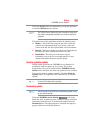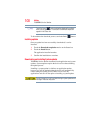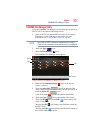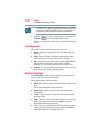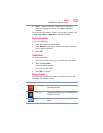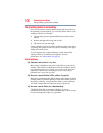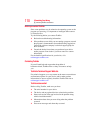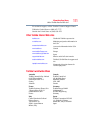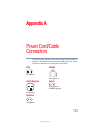
107
If Something Goes Wrong
Power and the batteries
Power and the batteries
Your device receives its power through the AC adaptor and power
cord/cable or from the system battery. Power problems are
interrelated. For example, a faulty AC adaptor or power cord/cable
will neither power the device nor recharge the batteries.
Here are some typical problems and how to solve them:
The Power light does not come on when you plug in the AC
adaptor and power cord/cable.
Make sure the AC adaptor and power cord/cable are firmly plugged
into both the wall outlet and the device.
If the Power light still does not come on, check that the wall outlet
is working properly by plugging in a lamp or other appliance.
The AC adaptor and power cord/cable work correctly, but the
battery will not charge.
The battery does not charge while the device is consuming full
power. Try turning off the device.
The battery may not be inserted correctly in the device. Turn off the
device, remove the battery, clean the contacts with a soft dry cloth
(if necessary) and replace the battery. See “Removing the battery
from the device” on page 32.
The battery may be too hot or too cold to charge properly. If you
think this is the probable cause, let the battery reach room
temperature and try again.
If the battery light does not glow after a few minutes, the battery
may have reached the end of its useful life. Try replacing it.
The battery appears not to power the device for as long as it
usually does.
If you frequently repeat shallow charge and discharge, the battery
meter may become inaccurate. Let the battery discharge
completely, then try charging it again.
Check the power options. For more information, see “Optimizing
battery life” on page 36. Have you added a device, such as a
memory module, that takes its power from the battery? Is your
software using the internal storage drive more? Is the display power
set to turn off automatically? Was the battery fully charged to begin
with? All these conditions affect how long the charge lasts.



